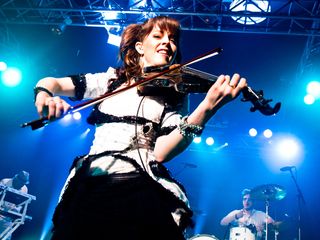
YouTube violin sensation Lindsey Stirling talks success and electronica
Piers Morgan almost crushed Lindsey Stirling like a butterfly on a wheel. In 2010, when Stirling made it to the quarter-finals on America's Got Talent, the broadcast journalist took a dim view of the dancing dubstep violinist, saying, "There were times in there when it was OK, and there were times when it sounded to me like a bunch of rats being strangled."
"I was so sad," Stirling says of her dismissal from the show. "When you hear something like that, and it's on TV for everybody else to witness, you think you're over."
After licking her wounds, Stirling dusted herself off and got crafty, putting out her own videos on YouTube, where they quickly found a sizable and loyal audience. Her classical-crossover/electronica clip of the song Crystallize has racked up an astonishing 83 million views, and her self-titled debut album has already sold over 180,000 copies in the US while going gold in both Germany and Switzerland.
Before heading off to the studio to work on her second album, Stirling sat down with MusicRadar to talk about her unique approach to electronic music and how she's mastered online marketing.
Hearing you play, it's not surprising that you've studied classical music.
“No, I definitely have. I took classical lessons for about 11 years. I started when I was about six years old. I had a private teacher and took lessons once a week. I did that till I was about 17.”
You were only into classical at that time?
“Pretty much, but when I was about 15, I started experimenting with different types of music. I joined a rock band and started playing along to a lot of my favorite radio hits. It was kind of my reward for practicing so much. I’d be like, ‘OK, now I’m done with my practicing – I can play to the Black-Eyed Peas!’ [Laughs] But until around then, it was all pretty much classically based.”
Did you play violin in the rock band? Ever try you hand at the guitar?
“It was with a violin. I saved up and my parents helped me buy an electric violin. I played these little house parties so that my friends could hear me play. Before I got the electric, my friends would complain: ‘We can never hear you!’ I tried doing it at first by just playing to a mic, but it still wasn’t loud enough. Getting the electric violin was the beginning of my itch to play on stage.”
Did the sound immediately work for you, putting the violin to rock?
“Oh, yeah! Not long after I joined the band, we discovered Yellowcard and were like, ‘Oh, cool! Here’s a band that people really like, and they’ve got a violinist, too.’ The violin, to me, can go with anything. That’s why I’ve been able to put it with dubstep and dance music; it’s why it works with rock ‘n’ roll. It’s an incredibly versatile instrument and can cross over a lot of boundaries, which is why I love doing what I do. Most people still see the violin as a classical instrument. It’s nice to break the mold.”
How did you start getting into electronic music? What was the first thing that hooked you?
“There was this techno radio station that in Arizona – 1011 or something. It came in really fuzzy, and you could hardly hear it, but I started listening to it and got really into what they played. I would listen to it on my way to school. Electronic music wasn’t that big in Arizona, but I just loved it. It was so much fun to dance to – it made me wanna move! [Laughs]
“I got really into electronic, which then led to me loving Daft Punk. From there, I discovered bands like Passion Pit and Phoenix. And then I got into Nero and Swedish House Mafia. Skrillex was what got me into dubstep, but that was years later.”
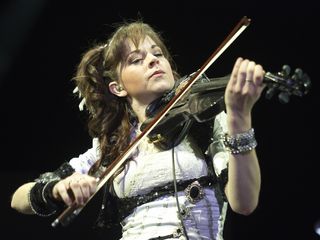
YouTube violin sensation Lindsey Stirling talks success and electronica
What EDM shows have you been to?
“I’ve been to a few. I’ve seen Nero; I’ve seen Passion Pit and Phoenix. And I’ve been to some festivals where you have this huge lineup of acts. Oh, I’ve seen Avicii, too. Those are some of the bigger shows I’ve been to.”
You studied film in college. If the music thing didn’t work out, were you hoping to be a director?
“It’s funny: I’ve always loved music, and I’ve always loved the violin, but I didn’t want to study it in college because I didn’t want it to become something I disliked. My sister majored in music, and so did some friends, and in talking to them about it I got this overwhelming feeling that it beat the love of music right out of them. They were told what to play, how to play, when to play. That wasn’t for me.
“I always loved film, too. In high school, I was making music videos with my friends – this was way before editing software was accessible. I’d plan the videos, I directed, I choreographed – it was a lot of fun. But then something happened when I was studying film: After two years of it, I just decided that I didn’t like being behind the camera, and I got sick of holding lights and editing by myself. I wanted to interact with people and be a part of the entertainment; I didn’t feel as though I was in my environment. So I ended up switching to be a therapist, and lo and behold, I wound up a violinist.” [Laughs]
When you started making your videos, were there any directors who influenced you? Who are some favorites?
“I love Christopher Nolan. Anytime you see him name in the credits, the film is guaranteed to be great. J.J. Abrams is amazing. When I was a kid, I loved Steven Spielberg; he has a very sentimental style.”
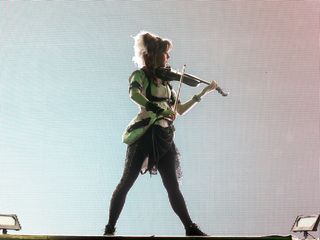
YouTube violin sensation Lindsey Stirling talks success and electronica
Did you have any trepidation about going on America’s Got Talent? Obviously, you had a bad encounter with Piers Morgan…
“You know, I was really nervous before I did it; I don’t think I’ve ever been that nervous before. I had never performed as a soloist – this was a new kind of music, me playing to hip-hop and dancing to it. I had only done it at home in front of a camera. It was me putting myself out there in a huge way. On the other hand, I was so excited to make it to the later rounds – ‘Oh, my God, this is my big break!’ So when it went so south for me in such a negative way, I was really crushed.
“It’s just funny looking back on it. Out of 100,000 people, I made it to the top 48. But all I could see at the time was the hurt and humiliation because I got voted off. I thought I was a failure. Then, after putting it off to the side for a little bit and thinking about it, I said, ‘No. I love this and I know I can make it.’ I ended up using it as motivation. ‘I’m gonna prove Piers Morgan wrong!’” [Laughs]
Did you look to people like Jean-Luc Ponty for inspiration? He’s done some rock…
“I was inspired by a woman named Vanessa-Mae. I think her heyday was in the ‘90s. She put the violin to techno music, and I thought she was fantastic. David Garrett is another big inspiration. He’s a virtuoso and was kind of like a prodigy. He puts the violin to big rock orchestras, Trans-Siberian Orchestra style. But the first ones to impress me were Bond – four really beautiful women who wore cool outfits. They played kind of like Latin rock and did shows for thousands of people. I saw that and thought, ‘OK, the violin can be cool…’ But I wanted to do it my own way.”
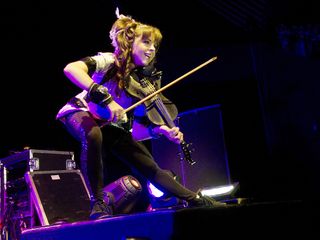
YouTube violin sensation Lindsey Stirling talks success and electronica
Your success on YouTube – is this all sort of a happy accident, or did you really research what it took to break on the channel?
“A little bit of both. Originally, I met a filmmaker named Devin Graham, and he wanted to do a video for me. He put it on his channel, and suddenly it got all of these hits. My music started selling – it was amazing. I went to him and asked him everything I could about YouTube. I researched it myself and studied. I learned that it’s not just happenstance – you can’t simply hope that things go viral – but rather, there is a formula for success. I worked super, super hard to get those first 100,000 subscribers. Now the ball is rolling, and I have a fan base that can spread things out there for me. But it’s hard at first. You have to break through.”
When you say “formula,” what exactly do you mean?
“You have to find your followers. You have to study YouTube and work it. A really effective way is to collaborate with other artists or other people on YouTube – if you can appear on their channel, then you can link it to your channel. So you’re sharing fans. You have to reach out to people who are into your sphere. Obviously, you can’t reach for the stars at first – you have to start with people who have 20,000 followers or below. But it works. Little by little, you build up.
“Also, I would go on Twitter and find artists who I thought had a similar audience to mine. For instance, I went to Yanni on Twitter, and I started following his followers. These people would be like, ‘Oh, this random chick is following me.’ But they would look at my thing, and a lot of them started following me back. So it’s about following the followers [laughs], but then they become your fans. Little things like that.
“Also, you have to be consistent with your posts. When I first started, I would post a new video every two weeks. It became like a TV station. My fans knew, ‘OK, every two weeks, on Tuesday, Lindsey’s gonna have a new video.’ It became something they could depend on. Stuff like that really matters.”
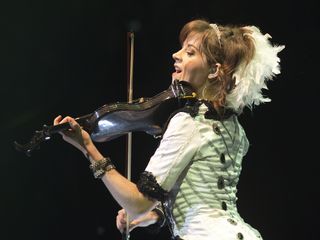
YouTube violin sensation Lindsey Stirling talks success and electronica
And social media, too.
“That’s a little game in itself. You know, when a new Lady Gaga record is coming out, the label has a lot of money to spend, so you know it’s there. They put her on billboards, and they put the music in commercials; she gets the cover of magazines. But when you’re using social media as your platform, it goes through a newsfeed and then it goes away. So you have to build up the numbers on all the platforms.
“Whenever I have a big announcement, I post it several times. I’ll post on Facebook, then an hour later I’ll do it on Twitter and so on. You catch the different people. You don’t want to spam people, so you have to be creative – fun pictures and stuff like that. And I do countdowns and competitions. You want people to come in and interact and be a part of things.”
What do you use to write and demo with? Do you have any kind of home recording setup?
“I’m very basic with my recordings. I have a very simple microphone, and I use GarageBand. I work with different producers, so we’ll write the backgrounds together. I’ll sit there in the studio, right when we’ve finished the beat, and I’ll just jam and jam and jam. If I do write from home, it's on GarageBand. My music editing skills are somewhat limited – I’m much better at film editing.”
You’re working on a new album – anything you can say about it?
“It’s going to be a slightly new Lindsey, but not a total departure. It’ll be EDM-style, with some dupstep and a little bit of a trance feel and some dance stuff. I think it’s a more mature, but it’s definitely ‘me.’ My current fans will like it, and hopefully some new people will check it out. But there are going to be two or three tracks with singers, and that’s been a lot of fun to write for. Being able to really say the things I want the music to say is cool – writing it in actual lyrics. I’m excited.”

Joe is a freelance journalist who has, over the past few decades, interviewed hundreds of guitarists for Guitar World, Guitar Player, MusicRadar and Classic Rock. He is also a former editor of Guitar World, contributing writer for Guitar Aficionado and VP of A&R for Island Records. He’s an enthusiastic guitarist, but he’s nowhere near the likes of the people he interviews. Surprisingly, his skills are more suited to the drums. If you need a drummer for your Beatles tribute band, look him up.

“If you want a good vocal, you gotta drink snake sperm”: Singer Jessica Simpson reveals the unusual drink that keeps her vocal cords in tip-top condition
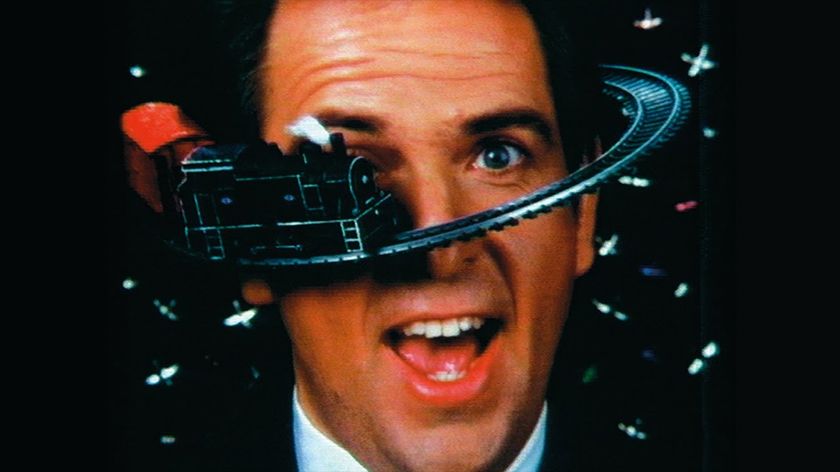
“I was thinking at the time, if anyone wants to try and copy this video, good luck to them!”: How ’60s soul music, African rhythms and a groundbreaking video fuelled Peter Gabriel’s biggest hit

“If you want a good vocal, you gotta drink snake sperm”: Singer Jessica Simpson reveals the unusual drink that keeps her vocal cords in tip-top condition

“I was thinking at the time, if anyone wants to try and copy this video, good luck to them!”: How ’60s soul music, African rhythms and a groundbreaking video fuelled Peter Gabriel’s biggest hit








